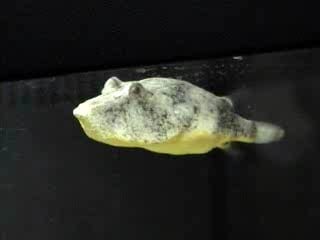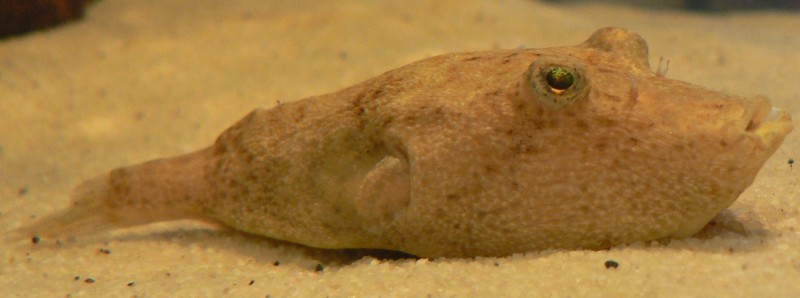The potato puffer or the Congo puffer is also known with the scientific name Tetraodon miurus. Now the Congo puffer fish is a very popular species among “oddball’ aquarists and has some interesting characteristics and care requirements for captivity. In general, the species is very intolerant of conspecifics, and it’s essential to recognize that behaviour can change over time, especially when the fish reaches sexual maturity; where it will likely become very territorial.
The first thing to note about the congo puffer fish is that it is not a particularly active species. This doesn’t mean that it’s boring or lacks character, but if you’re looking for a pufferfish who is going to come and greet you at the glass and is going to be visible at all times, then this probably isn’t the species for you.
The Congo puffer fish is a wallowing species meaning that it buries itself in the substrate. This is how the fish will spend the overwhelming majority of its time. This is also how the species naturally hunt ready to launch a surprise attack on any prey items that may swim by.
LENGTH OF CONGO PUFFER FISH
The Congo pufferfish will grow to lengths of approximately 15 centimetres and is completely freshwater.
LIFE EXPECTANCY
Congo pufferfish can live for 10 years in the freshwater aquarium if raised under suitable conditions.
COLORS OF CONGO PUFFER FISH
The Congo pufferfish is capable of metachrosis, which is the ability to change colour. The colour may appear brown, orange, yellow, cream, olive green, grey, black and red. It will often change its colour to camouflaged against its surroundings. Red variants of this species are highly sought after, and they are frequently referred to as red Congo’s or red potatoes.
TANK SIZE AND CAPACITY
Since the reason that the Potato Puffer Fish or Congo Puffer Fish attacks its mates, it should be provided with a soft, sand substrate – that is at least 5 centimetres deep – so the fish can exhibit these natural behaviours.
Tank Area – 3600 sq.cms
Height – 30cms
The capacity of the tank – 100litres (minimum)

WATER FOR CONGO PUFFER FISH
Maintain a pH between 6.5 and 7.5 – with 7 being the optimum – and keep it in a temperature between 74°-78°F(25 – 28 Celsius), other parameters such as Hardness should be 10-15°H for congo puffer fish and they will be fine with low water current.
FILTERS
The mirrors most commonly inhabit the very clean, fast-flowing and highly oxygenated waters of the Congo River Basin and many of its tributaries. These conditions need replicating in the aquarium, with a medium to strong flow and frequent partial water changes to maintain excellent water quality.
So, in order to serve this purpose, we use Oxygen filters which multiplies oxygen in the water throughout the tank and additionally moves from top to base of tank so that oxygen gets distributed throughout and a fountain could help in circulating air across the water tank.
It is even achieved by other spray bars from a canister filter which can be slightly angled towards the surface of the water, which will create lots of agitation, facilitating gas exchange and ensuring that the water is always highly oxygenated.
TANK MATES
In the wild, the Congo pufferfish naturally preys upon other fish, which is why it is important to keep them with no other tank mates. Some keepers enjoy [short-term] success in keeping groups and Congo pufferfish together. Well, this isn’t something that I recommend.

FEED FOR CONGO PUFFER FISH
- One of the most important elements in keeping the Congo pufferfish is to provide a varied and balanced diet, containing the right foods to ensure that its nutritional needs are being met. The Congo pufferfish is primarily a piscivorous [fish eating] species, but it will also eat the occasional worm or small insects.
The Congo pufferfish should not be offered cockles, snails, mussels or similar molluscs. Instead of eating these hard-shelled foods, this species maintains its fast-growing teeth by crunching through the bones of its prey.
My preferred foods for these fish include fish meat – which is cut into manageable chunks, sand eels’ earthworms, cockroaches, crickets, locusts and woodlice. Some areas of the internet may recommend the use of live feeder fish for this species, which is something that I don’t recommend. Congo pufferfish does not need to eat live fish in order to thrive in your home aquarium, and it will often readily accept frozen thawed foods immediately after settling in.
FEEDING RISKS
Feeder fish are often bred and squalid and overstock systems where bacteria such as columnaris and parasites can spread through very quickly. Feeding these fish to your puffer greatly increases the chance of introducing one of these harmful pathogens, to your beloved pet who then may become sick and require treatment.
Some feeder fish depending on the species may also contain thiaminase. Thiaminase is an enzyme that breaks down or inactivates Vitamin B1. Vitamin B1 is an essential nutrient to most animals, including fish as it converts carbohydrates into glucose and is particularly important in nervous system function.
This species must be offered a wide selection of foods and foods containing thiaminase must not make up any more than 20% of the fish’s overall diet.
